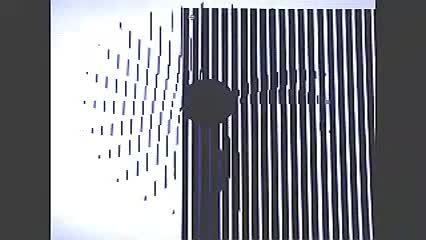 | ||
Barrier-grid animation (also known as "picket fence" animation and often referred to by the genericized trademark "Scanimation"), is an animation effect created by moving a striped acetate overlay across an interlaced image. Its development can also be regarded as a step towards lenticular printing, while the technique remained as a relatively cheap and simple way to produce animated images in print.
Contents
Motograph
The Motograph Moving Picture Book was published in London at the start of 1898 by Bliss, Sands & Co.. It came with a "transparency" with black stripes to add the illusion of motion to the pictures in the book (13 in the original black and white edition and 23 in the later color edition). The expanded "new edition" had a cover design "specially drawn for the book" by famous french painter Henri de Toulouse-Lautrec, depicting a woman viewing pictures with the transparency (accompanied by a girl, a man and three different pets). The illustrations were credited to "F.J. Vernay, Yorick, &c.".
W. Symons received British Patent No. 5,759 on March 14, 1896 for this technique. It uses different hatching patterns in the pictures, causing moiré type effects when the striped transparency is moved across it. It creates a vibrant type of motion illusion with revolving wheels, billowing smoke, ripples in water, etc.
Frederic Ives patents
Frederic Eugene Ives used "transparent-line screen, consisting of opaque lines with clear spaces between them" placed at a little distance in front of interlaced photographic strips. Originally for a "parallax stereogram" patented in the U.S. in 1903 and a year later for a "Changeable sign, picture, &c.". Animated motion seems not to have been a part of Ives' ideas.
Magic moving picture cards
Magic moving pictures were composed of images containing black vertical and regularly interlaced stripes, alternating between two or three phases of a depicted motion or between distinctly different pictures. A little transparent sheet with regular vertical black stripes was glued beneath a window in a cardboard envelope holding the picture card. The card was pulled out and pushed back in to produce the illusion of change or motion. The technique was patented in the United States on August 28, 1906 by Alexander S. Spiegel as a nameless "display device" (application date November 29, 1905}. It was marketed under this patent as Magic moving pictures by G. Felsenthal & Co and as Magic moving picture card by the Franklin Postcard Company, both from Chicago. The latter produced a card in 1912 which enabled the viewer to chose between the portraits of three presidential candidates during that year's u.s. presidential elections. Spiegel patented several improvements, the last in 1911.
Similar cards have been published in Japan around 1920 as Cinematograph by SK and in France around 1940 as Mon cinema chez moi.
Animated portrait photographs
The earliest known examples of photographs animated with a line-screen technique were made by Eugène Estanave in 1906. He used a glass line screen placed a few millimeters in front of an interlaced stereoscopic glass plate photograph. Estanave seems not to have commercialized his technique. Others soon marketed similarly animated photographs with plastic screens, but these are as likely based on Spiegel's Magic Moving Cards. Animated portrait postcards were a popular product in the 1910s and 1920s. Personal portraits were offered by several studios with specialized equipment.
Ombro-Cinéma
Ombro-Cinéma toys operated on rotating scrolls of paper with sequences of images printed as interlaced two-frame animations: thin regularly-spaced vertical stripes of one frame of the animation were alternated with stripes of the next frame, alternately hidden by regularly-spaced black vertical stripes on a transparent viewing pane. In some versions the stripes on the viewing pane were disguised as a picket fence. Ombro-Cinema toys had of a wooden or cardboard chassis with a rack and hand-crank for cycling the image scroll across the viewing pane. In some versions a wind-up clockwork mechanism transferred the scroll while operating a music box.
The Ombro-Cinéma toy was produced by Saussine Ed. in Paris and patented in 1921 and six months later received a gold medal at the 19th Concours Lépine. Saussine had previously published versions with regular non-animated silhouettes on the scroll, as Ombres Chinoises (Chinese Shadows), patented in 1897. Both toys were named after and inspired by the Ombres Chinoises shadow play that had been very popular in France since 1772. Some of the animated Ombro-Cinéma toys are found with the same oriental design and Ombres Chinoises or Theatre Ombres title, but most had a design with Charlie Chaplin's Tramp character and Charles Prince's Rigadin (also interpreted as Fatty Arbuckle) on the proscenium and box. The Ombro-Cinéma received a gold medal
At least fourteen different "films" with twelve images each were available, ten in black and white and four in color. The strips varied in length from circa 2.5 meters to more than 4 meter.
Series in black and white:
Series in color:
A French version from around 1950 was named Ciné Enfantin. Similar wind-up musical toy "televisions" have been produced until late in the 20th century.
French circular disc versions inside children's picture books were produced in the 1940s as Album télévision and Livre de Télévision.
Kinegram
Visual artist Gianni A. Sarcone describes the kinegram as using elements of the Moiré pattern and the zoetrope (one of the precursors of film animation). It works by placing an acetate overlay containing vertical stripes over a specially prepared image and slowly moving the overlay horizontally.
Scanimation
A device under the brand name Scanimation, incorporating sliding striped acetate sheets into book pages or folding cards to produce six-phase barrier grid animations at each page, was invented by Rufus Butler Seder and patented in 2006 under US Patent #7151541. The first book Gallop! was followed by Swing!, Waddle!, Santa and licensed scanimation books of Star Wars, The Wizard of Oz and Peanuts.
